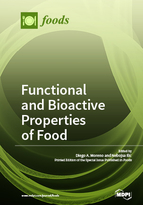Functional and Bioactive Properties of Food
A special issue of Foods (ISSN 2304-8158). This special issue belongs to the section "Food Nutrition".
Deadline for manuscript submissions: closed (28 February 2018) | Viewed by 105793
Special Issue Editors
Interests: food science and technology; phytochemistry; bioactive compounds; health-promoters, functional ingredients; natural foods; healthy foods; energy metabolism (obesity and diabetes); human nutrition; wellbeing
Special Issues, Collections and Topics in MDPI journals
Interests: Food Science and Technology; Natural Products Chemistry; Bioactive Compounds of Plant-Derived Foods; Structure – Function and Bioactivity of Plant Substances for Health
Special Issue Information
Dear Colleagues,
Over the last 20 years, many research groups and teams, as well as different projects and resulting publications, have considered as relevant the change in the vision of producing foods, not only for nutrition, but also for health. Diet and nutrition are key tools in promoting health and reducing the comorbidities of chronic diseases. There are thousands of biomolecules in fruits, vegetables, wild and medicinal plants, other land and marine organisms, which can exert functional and health-promoting effects through bioactivity beyond nutrition.
There are many opportunities and challenges in establishing connections between the bioactivity in foods and ingredients with benefits on health. The evidence still is not clearly presented, there are difficulties in demonstrating causality, and the multifactorial conditions of chronic and non-communicable diseases (e.g., obesity, diabetes, metabolic syndrome, etc.), which are not related to a single effect or a single compound. Additionally, the translation from lab to clinical studies still does not give enough support for claims, and more evidence is needed to give recommendations and dietary advice.
From the enormous amount of knowledge generated from different natural bioactive ingredients present in foods, we are aiming to bring together experts working in different fields of food, nutrition, and health, in order to work on this Special Issue, with a comprehensive collection of papers to gain insight into the most promising bioactive compounds in different foods, to improve the preservation of bioactivity during the food processing chain, and to provide scientific evidence of the efficacy of key bioactives in foods in preventing disease and improving health and well being.
Dr. Diego A. Moreno
Dr. Nebojsa Ilic
Guest Editors
Manuscript Submission Information
Manuscripts should be submitted online at www.mdpi.com by registering and logging in to this website. Once you are registered, click here to go to the submission form. Manuscripts can be submitted until the deadline. All submissions that pass pre-check are peer-reviewed. Accepted papers will be published continuously in the journal (as soon as accepted) and will be listed together on the special issue website. Research articles, review articles as well as short communications are invited. For planned papers, a title and short abstract (about 100 words) can be sent to the Editorial Office for announcement on this website.
Submitted manuscripts should not have been published previously, nor be under consideration for publication elsewhere (except conference proceedings papers). All manuscripts are thoroughly refereed through a single-blind peer-review process. A guide for authors and other relevant information for submission of manuscripts is available on the Instructions for Authors page. Foods is an international peer-reviewed open access semimonthly journal published by MDPI.
Please visit the Instructions for Authors page before submitting a manuscript. The Article Processing Charge (APC) for publication in this open access journal is 2900 CHF (Swiss Francs). Submitted papers should be well formatted and use good English. Authors may use MDPI's English editing service prior to publication or during author revisions.
Keywords
- Food
- Nutrients
- Bioactives
- Bioavailability
- Nutrition and Metabolism
- Health








